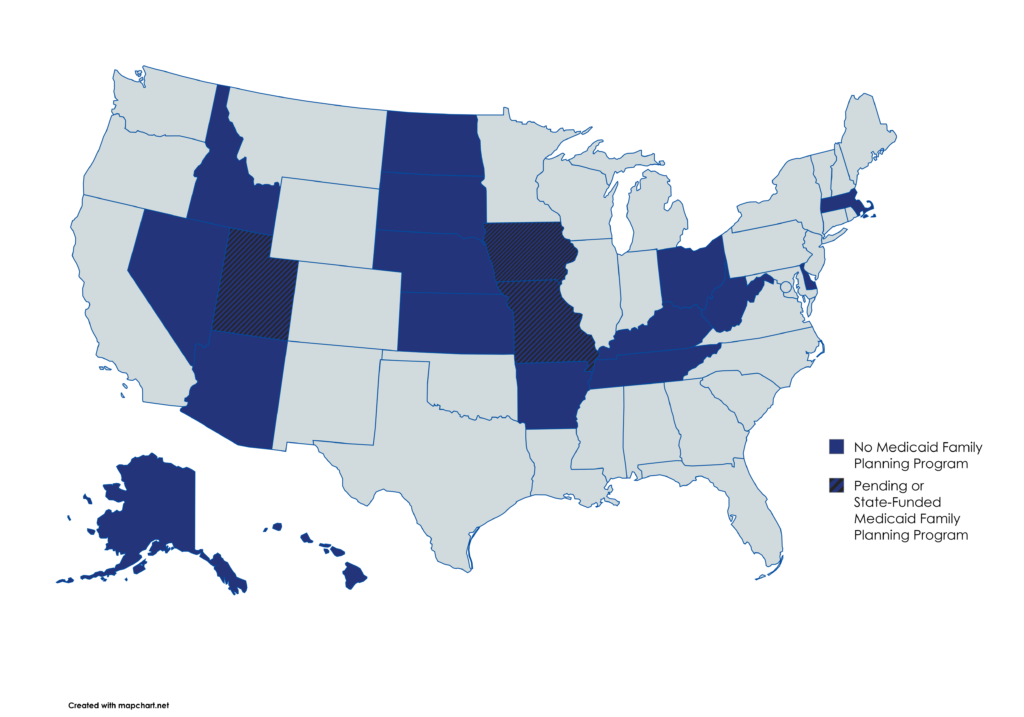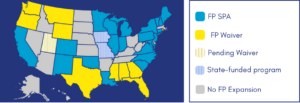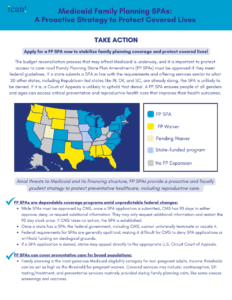Protect coverage and access in your state with a Family Planning SPA!

Family Planning SPAs ensure that people of all ages can access critical preventative and primary health care services —and they’re good for state budgets! Learn more about why your state should adopt a Family Planning SPA!
Apply for a FP SPA now to stabilize family planning coverage and protect covered lives!
The budget reconciliation process that may affect Medicaid is underway, and it is important to protect access to care now! Family Planning State Plan Amendments (FP SPAs) must be approved if they meet federal guidelines. If a state submits a SPA in line with the requirements and offering services similar to what 20 other states, including Republican-led states like IN, OK, and SC, are already doing, the SPA is unlikely to be denied. If it is, a Court of Appeals is unlikely to uphold that denial. A FP SPA ensures people of all genders and ages can access critical preventative and reproductive health care that improves their health outcomes.

Amid threats to Medicaid and its financing structure, optimizing your state’s FP SPA provides a proactive and fiscally prudent strategy to protect preventative healthcare, including reproductive care.
- FP SPAs are dependable coverage programs amid unpredictable federal changes:
- The federal government, including CMS, cannot unilaterally terminate or vacate existing, approved SPAs.
- If a state’s existing SPA needs updated to expand coverage, eligibility, or access, the state must submit an additional SPA to CMS for approval. Once an application is submitted, CMS has 90 days to either approve, deny, or request additional information. If CMS takes no action, the SPA is established.
- Federal requirements for SPAs are generally apolitical, making it difficult for CMS to deny SPA applications or updates, or withhold funding on ideological grounds.
- If a SPA application is denied, states may appeal directly to the appropriate U.S. Circuit Court of Appeals
- FP SPAs can cover preventative care for broad populations:
- Family planning is the most generous Medicaid eligibility category for non-pregnant adults. Income thresholds can be set as high as the threshold for pregnant women. Covered services may include: contraception, STI testing/treatment, and preventative services routinely provided during family planning visits, like some cancer screenings and vaccines.
- FP SPAs prevent people from becoming truly uninsured if Medicaid Expansion is dismantled:
- Because the income threshold for FP SPAs is higher than the Expansion group, anyone who was enrolled in Expansion can enroll in FP coverage if Expansion ends.
- Some states with existing FP SPAs, like IL, IN, NH, NC, and VA, have trigger laws that end their Expansion programs if the Expansion FMAP is reduced, and NM has a law requiring mitigation of the financial impact of the end of Expansion. FP SPAs can cover the 2.7 million people in trigger law states who will immediately lose coverage if the FMAP is reduced.
- FP SPAs provide cost savings to states:
- For every $1 invested in family planning, a state saves $7.09 of public money that would otherwise have gone to Medicaid-covered maternity, infant, child, and miscarriage care, as well as STI, infertility, and cancer treatment.
- FP SPAs are a fiscally prudent option if Congress reduces FMAP rates:
- FP SPAs provide states another means to cover individuals’ family planning care at a 90% match rate. If Congress reduces the Expansion FMAP. Expanding the scope of covered family planning services maximizes the care provided at a 90% match.
- If both the Expansion and family planning FMAP rates are reduced, every dollar invested in family planning matched at the regular FMAP rate still results in significant cost savings of public money that would otherwise have gone to Medicaid-covered care matched at the same reduced FMAP rate.
- FP SPAs increase federal Medicaid dollars paid to states under per capita caps:
- Under per capita caps, federal Medicaid dollars are allotted based on enrollment. FP SPA enrollees would count toward a state’s enrollment numbers and thus increase a state’s federal assistance amount.
- States can auto-enroll eligible individuals rolling off of Expansion or postpartum coverage into FP SPA coverage through their ex parte review processes to ensure every covered life is counted.
- FP SPA enrollees are only eligible for limited services, so are likely to bring in more money to the state Medicaid budget than states will likely spend on their care.
- FP SPs preserve Medicaid dollars under block grants or aggregate caps:
- FP SPAs ensure Medicaid dollars limited by block grants or aggregate caps are spent in the most efficient and cost effective way—on prevention—rather than on more costly treatment. FP SPAs ensure limited Medicaid dollars are not drawn down to cover prenatal, labor, delivery, and postpartum care for a person who would have chosen to avoid pregnancy if they had access to coverage through a FP SPA.
- FP SPAs safeguard against religious refusals of contraceptive coverage:
- If the Trump administration allows more types of employers to refuse to cover contraceptives on religious grounds, many individuals will need alternative coverage for birth control through FP SPAs.
- FP SPAs must be a Medicaid priority because the coverage they provide is critical for this moment when women’s health is under threat:
- Demand for contraceptive care has skyrocketed post-election. Some reports indicated a 760% increase in IUD appointments and a 460% increase in emergency contraception sales. FP SPAs ensure people have coverage for the reproductive healthcare they need at a time when that care is increasingly threatened.
Click the image below to download and share this resource.
Connect with us!
icancoverall.org






